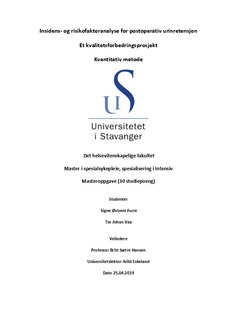| dc.contributor.advisor | Hansen, Britt Sætre | |
| dc.contributor.advisor | Eskeland, Arild | |
| dc.contributor.author | Furre, Signe Østrem | |
| dc.contributor.author | Vaa, Tor Johan | |
| dc.date.accessioned | 2019-07-12T11:24:55Z | |
| dc.date.available | 2019-07-12T11:24:55Z | |
| dc.date.issued | 2019-04-25 | |
| dc.identifier.uri | http://hdl.handle.net/11250/2605140 | |
| dc.description | Master's thesis in Nursing science | nb_NO |
| dc.description.abstract | BACKGROUND: Postoperative urinary retention (POUR) is a common complication following surgical procedures or anesthesia. POUR may cause bladder dysfunction, infections, discomfort and increased cost. Intensive care nurses are required to adhere to both professional and legal duties to prevent postoperative complications. Evidence-based guidelines have been implemented in the post anesthesia care unit (PACU). Despite these recommendations POUR frequently occurs. No attempts to re-assess the quality of care have been made. AIM: The aim was to detect incidence of POUR and define risk factors of developing POUR in the PACU. This quality improvement project will provide insight to an evidence-based approach for current handling of postoperative patients. METHODS: Prospective cohort study. Internal quality improvement project. RESULTS: 440 patients were included in the data analysis. An incidence of 4.1% (n=18) at primary bladder scan and an overall incidence of 8.2% (n=36) was found. Spinal anesthesia, lower urinary tract symptoms (LUTS) and body temperature <36oC increased the risk of POUR. Symptoms of POUR and primary bladder scan volumes ≥200 ml were associated with POUR during admittance to PACU. Age ≥50 years, spinal anesthesia, orthopedic surgery and LUTS was found to increase mean relevant bladder scan volumes. CONCLUSION: A significant number of patients developed POUR while admitted to PACU. We identified several risk factors associated with POUR. We recommend repeated use of bladder scanners throughout the perioperative phase. An evidence-based approach to early detection, prevention, and handling of POUR is essential to reduce harm, infections, and cost. This will contribute to increased patient safety and quality improvement of care conducted at the PACU as well as professional development in intensive care nursing. | nb_NO |
| dc.description.abstract | BAKGRUNN: Postoperativ urinretensjon (POUR) er en vanlig komplikasjon etter kirurgiske inngrep eller anestesi. POUR kan medføre blæredysfunksjon, infeksjon, ubehag og økte kostnader. Intensivsykepleierens ansvars- og funksjonsbeskrivelse stiller krav til behandling og forebygging av postoperative komplikasjoner. Kunnskapsbaserte retningslinjer og anbefalinger har blitt innført på postoperativ avdeling (PACU). Til tross for disse anbefalingene ser en at POUR fortsatt forekommer. Ingen forsøk på å re-evaluere eller kvalitetssikre behandlingen har blitt utført.
HENSIKT: Hensikten var å undersøke insidens av POUR og identifisere mulige risikofaktorer for utvikling av POUR. Dette kvalitetsforbedringsprosjektet vil bidra med innsikt til kunnskapsbasert praksis om håndtering av postoperative pasienter ved PACU.
METODE: Prospektiv kohortstudie. Et internt kvalitetsforbedringsprosjekt.
RESULTATER: 440 pasienter ble inkludert i dataanalysen. Vi fant en insidens av POUR på 4.1% (n=18) ved første post-operative blæreskann. Total insidens av POUR i PACU var 8.2% (n=36). Spinalanestesi, LUTS (Lower Urinary Tract Symptoms) og kroppstemperatur <36oC ga økt risiko for POUR. Symptomer på POUR og skannet primært volum ≥200 ml ble assosiert med økt risiko for utvikling av POUR under oppholdet på PACU. Alder ≥50 år, spinalanestesi, ortopedi og LUTS ga gjennomsnittlig økt relevant blæreskanningsvolum.
KONKLUSJON: Flere pasienter utviklet POUR inneliggende på PACU. Vi identifiserte flere signifikante risikofaktorer for POUR. Vi anbefaler hyppig blæreskanning gjennom hele det perioperative forløpet for tidlig avdekking av POUR og å forhindre pasientskade. En kunnskapsbasert tilnærming til avdekking, forhindring og håndtering av POUR er essensielt for å redusere skade, infeksjoner og økte kostnader. Dette vil bidra til økt pasientsikkerhet og kvalitetsforbedring av behandlingen som utføres på PACU samt faglig utvikling av intensivsykepleiefaget. | nb_NO |
| dc.description.sponsorship | None | nb_NO |
| dc.language.iso | nob | nb_NO |
| dc.publisher | University of Stavanger, Norway | nb_NO |
| dc.relation.ispartofseries | Masteroppgave/UIS-HV/2019; | |
| dc.rights | Attribution-NonCommercial-NoDerivatives 4.0 Internasjonal | * |
| dc.rights.uri | http://creativecommons.org/licenses/by-nc-nd/4.0/deed.no | * |
| dc.subject | helse- og sosialfag | nb_NO |
| dc.subject | POUR | nb_NO |
| dc.subject | postoperative urinary retention | nb_NO |
| dc.subject | spesialsykepleie | nb_NO |
| dc.subject | risk factor | nb_NO |
| dc.subject | bladder overdistention | nb_NO |
| dc.subject | bladder scanner | nb_NO |
| dc.title | Postoperative urinary retention - an incidence and risk factor analysis in a general post anesthesia care unit. A quality improvement project. | nb_NO |
| dc.type | Master thesis | nb_NO |
| dc.description.version | submittedVersion | nb_NO |
| dc.rights.holder | Authors. | nb_NO |
| dc.subject.nsi | VDP::Medical disciplines: 700::Health sciences: 800::Nursing science: 808 | nb_NO |

